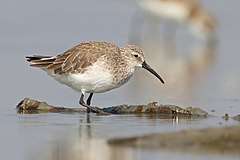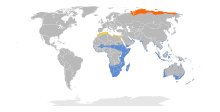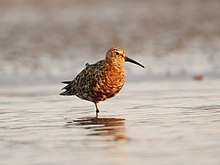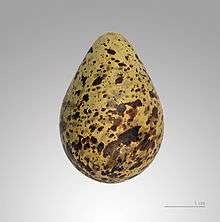Curlew sandpiper
The curlew sandpiper (Calidris ferruginea) is a small wader that breeds on the tundra of Arctic Siberia.[2] The genus name is from Ancient Greek kalidris or skalidris, a term used by Aristotle for some grey-coloured waterside birds. The specific ferruginea is from Latin ferrugo, ferruginis, "iron rust" referring to its colour in breeding plumage.[3]
| Curlew sandpiper | |
|---|---|
 | |
| Scientific classification | |
| Kingdom: | Animalia |
| Phylum: | Chordata |
| Class: | Aves |
| Order: | Charadriiformes |
| Family: | Scolopacidae |
| Genus: | Calidris |
| Species: | C. ferruginea |
| Binomial name | |
| Calidris ferruginea (Pontoppidan, 1763) | |
 | |
| Synonyms | |
|
Erolia ferruginea Vieillot, 1816 | |
It is strongly migratory, wintering mainly in Africa, but also in south and southeast Asia and in Australia and New Zealand.[4] It is a vagrant to North America.
Description


These birds are small waders, similar to dunlins,[5] but differ in having a longer down-curved beak, longer neck and legs and a white rump. They have a length of 18–23 cm (7.1–9.1 in) and wingspan of 38–41 cm (15–16 in). The breeding adult has patterned dark grey upperparts and brick-red underparts. In winter, this bird is pale grey above and white below, and shows an obvious white supercilium. Juveniles have a grey and brown back, a white belly and a peach-coloured breast.
Behaviour
The male curlew sandpiper performs an aerial display during courtship. The clutch of 3–4 eggs are laid in ground scrape in the tundra and taiga, mostly in Siberia.
It is extremely difficult to measure breeding success or population trends in their breeding grounds because nests are scattered over a vast region and their positions influenced by localised weather.
Of all shorebird species, the curlew sandpiper has the smallest breeding range in relation to its non-breeding range. After breeding these birds migrate south to Africa, Australasia or India. South Africa is at the southern limit of the migration path from Siberia, 15,000 km (9,300 mi) or 130° of latitude away.
This wader is highly gregarious, and will form flocks with other calidrid waders, particularly dunlin. Despite its easterly breeding range, this species is regular on passage in western Europe, presumably because of the southwesterly migration route.
It forages in soft mud on marshes and the coast, mainly picking up food by sight. It mostly eats insects and other small invertebrates.
The numbers of this species (and of little stint) depend on the population of lemmings. In poor lemming years, predatory species such as skuas and snowy owls will take Arctic-breeding waders instead.
Counts of the birds in South Africa, specifically at Langebaan Lagoon where they are most numerous, indicate a 40% decline in numbers between 1975 and 2009. A similar trend has been noted in Australia and may be linked to effects of global warming at the breeding grounds.[6]
This species occasionally hybridizes with the sharp-tailed sandpiper and the pectoral sandpiper, producing the presumed "species" called "Cooper's sandpiper" ("Calidris" × cooperi) and "Cox's sandpiper" ("Calidris" × paramelanotos), respectively.
Taxonomy
This is a fairly unusual species, and has been proposed as type species of the genus Erolia but the DNA sequence data is currently insufficient to resolve its relationships.[7] This matter is of taxonomic relevance since, as the curlew sandpiper is the type species, a close relationship with the small "stint" sandpipers would preclude the use of Erolia for the present species.
The curlew sandpiper is one of the species to which the Agreement on the Conservation of African-Eurasian Migratory Waterbirds (AEWA) applies.
References
- BirdLife International (2012). "Calidris ferruginea". IUCN Red List of Threatened Species. 2012. Retrieved 26 November 2013.CS1 maint: ref=harv (link)
- Stephen Moss (21 September 2014). "Birdwatch: Curlew sandpiper". The Guardian.
- Jobling, James A (2010). The Helm Dictionary of Scientific Bird Names. London: Christopher Helm. pp. 84, 159. ISBN 978-1-4081-2501-4.
- Thomas Alerstam (1993). Bird Migration. Cambridge University Press. p. 61.
- "Curlew sandpiper". RSPB.
- de Villiers, M.S., ed. (2009). Birds and Environmental Change: building an early warning system in South Africa. Pretoria: SANBI. p. 12. ISBN 978-0-620-45305-9.
- Thomas, Gavin H.; Wills, Matthew A.; Székely, Tamás (2004). "A supertree approach to shorebird phylogeny". BMC Evolutionary Biology. 4: 28. doi:10.1186/1471-2148-4-28. PMC 515296. PMID 15329156. Supplementary Material
External links
| Wikimedia Commons has media related to Calidris ferruginea. |
| Wikispecies has information related to Calidris ferruginea |
- Curlew sandpiper species text in The Atlas of Southern African Birds Archived 2015-07-18 at the Wayback Machine
- Pictures of curlew sandpiper at Birdlife Finland Archived 2018-10-19 at the Wayback Machine
- Identification article on autumn curlew sandpipers
- Ageing and sexing (PDF; 1.4 MB) by Javier Blasco-Zumeta & Gerd-Michael Heinze
- BirdLife species factsheet for Calidris ferruginea
- "Calidris ferruginea". Avibase.

- "Curlew sandpiper media". Internet Bird Collection.
- Curlew sandpiper photo gallery at VIREO (Drexel University)
- Interactive range map of Calidris ferruginea at IUCN Red List maps
- Audio recordings of Curlew sandpiper on Xeno-canto.
- Calidris ferruginea in the Flickr: Field Guide Birds of the World
- Curlew sandpiper media from ARKive

